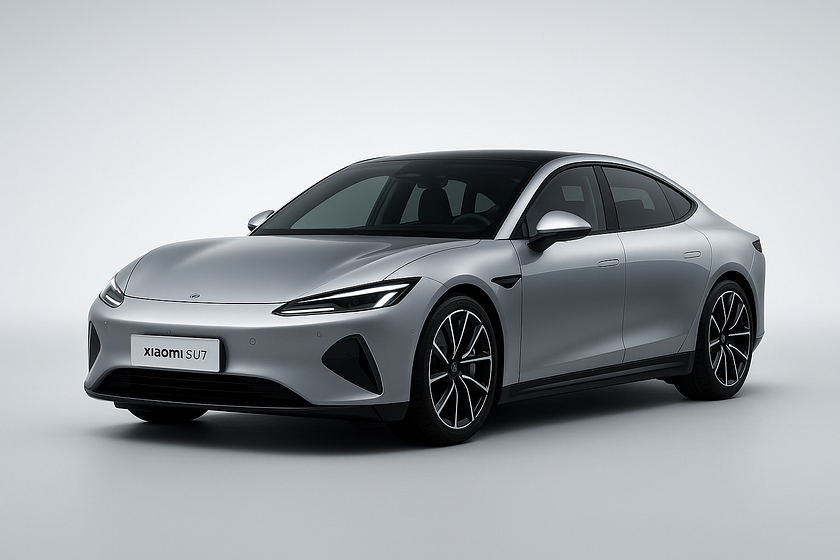Xiaomi SU7: The Electric Disruptor from a Tech Giant

The automotive world is witnessing a revolution, not from a traditional car manufacturer, but from a name synonymous with smartphones and smart gadgets — Xiaomi. With the launch of its highly anticipated Xiaomi SU7, the Chinese tech giant has officially stepped into the electric vehicle (EV) market, signaling a bold new chapter in its evolution. But is the SU7 just another EV, or is it a true disruptor? Let’s take a closer look.
From Smartphones to Supercars?
Xiaomi has built its empire on offering high-quality, tech-forward products at competitive prices. With smartphones, smart TVs, wearables, and even home appliances under its belt, venturing into electric vehicles might seem like a surprising move. But this expansion is aligned with the company’s long-term vision to become a comprehensive technology ecosystem provider.
The SU7 is Xiaomi’s first electric car under the newly formed Xiaomi EV division. It’s not just a side project or an experiment — it’s a meticulously engineered, high-performance sedan that aims to go head-to-head with premium EVs like the Tesla Model 3 and Porsche Taycan.
Sleek Design, Sporty DNA
The first thing that grabs attention about the Xiaomi SU7 is its design. This is no clunky first attempt. The SU7 boasts a sleek, aerodynamic silhouette with sculpted lines and a low stance. It radiates sporty elegance, with sharp LED headlights, a sloping roofline, and a wide rear track that gives it a confident road presence.
Xiaomi clearly took inspiration from both the aesthetics of luxury sports sedans and the performance-first approach of premium EVs. The result is a car that looks just as much at home on a racetrack as it does on urban roads.
Inside, the SU7 features a minimalist yet high-tech cabin. A large central display dominates the dashboard, flanked by a digital instrument cluster and ambient lighting. Every element feels connected, part of a seamless user experience — something Xiaomi has long been known for in its consumer electronics.
Power and Performance
Under the hood — or rather, beneath the floor — lies the real heart of the SU7: Xiaomi’s self-developed HyperEngine electric drive system. Early specs suggest the car will be available in multiple configurations, with performance versions delivering a top speed of over 265 km/h (165 mph) and a 0–100 km/h (0–62 mph) acceleration time of just 2.78 seconds.
These figures place it firmly in the realm of high-performance EVs, challenging established names like Tesla’s Performance line-up. Xiaomi has also worked closely with CATL (Contemporary Amperex Technology Co. Limited), one of the world’s leading EV battery manufacturers, to ensure range and efficiency meet market expectations. The long-range variant of the SU7 is rumored to offer up to 800 km (about 497 miles) on a single charge under CLTC testing.
Software-Centric Driving Experience
What truly sets the Xiaomi SU7 apart is the software. Xiaomi’s strength lies in its seamless ecosystem, and the SU7 is an extension of that. The car is deeply integrated with Xiaomi’s proprietary operating system, Xiaomi HyperOS, which unifies smartphones, tablets, smart home devices, and now, electric vehicles.
From navigation and entertainment to smart climate control and AI-powered driver assistance, everything is accessible through a single, cohesive interface. Imagine having your Xiaomi smartphone, home devices, and car all communicating with each other — setting your car’s climate from your phone or syncing your driving preferences across devices.
Additionally, the SU7 is expected to feature advanced autonomous driving capabilities, supported by Xiaomi’s self-developed Pilot Pro driving system, which utilizes an array of LiDAR sensors, cameras, and AI algorithms to deliver Level 2+ to Level 3 automation in future versions.
A Price Game-Changer?
Xiaomi is known for delivering flagship performance at mid-tier prices — and it’s bringing that philosophy to its EV venture. While exact pricing varies by market and variant, the SU7 is expected to undercut most of its rivals significantly. This aggressive pricing strategy is likely to shake up the EV market, especially in regions where price remains a barrier to adoption.
If Xiaomi can deliver premium design, high-end performance, and smart technology at a lower price point, it could carve out a massive share in the EV space, especially in price-sensitive markets like India, Southeast Asia, and Eastern Europe.
Challenges Ahead
Despite the excitement, the road ahead for Xiaomi isn’t without bumps. The EV industry is capital-intensive and competitive, with tight regulatory requirements, supply chain constraints, and evolving consumer expectations. Unlike gadgets, cars require years of testing, infrastructure support, and post-sale service.
Moreover, customer trust in a brand new carmaker — albeit a tech giant — will take time to build. The success of the SU7 will largely depend on Xiaomi’s ability to scale manufacturing, ensure quality control, and provide reliable after-sales support.
Final Thoughts
The Xiaomi SU7 is not just a car — it’s a statement. It signals the blurring lines between the tech and automotive industries, showing how innovation from the digital world can redefine traditional manufacturing.
With its stylish design, impressive performance, and deeply integrated tech ecosystem, the SU7 is more than a debut — it’s a wake-up call to legacy automakers. If Xiaomi plays its cards right, it won’t just be selling electric cars — it will be leading a smart mobility revolution.

Comments
Post a Comment